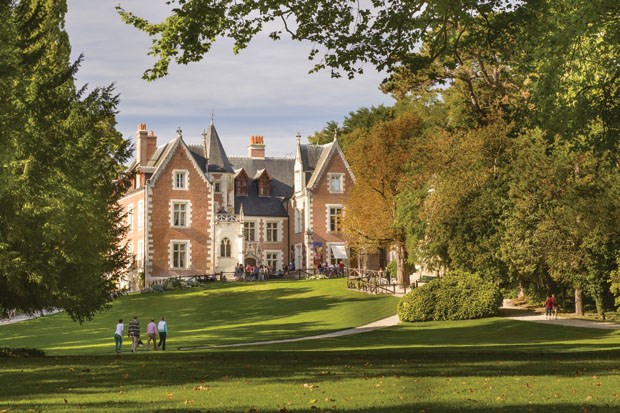Site of France's early royal court and Leonardo da Vinci's last home, Amboise inspires wondrous investigations.
Strolling across the main bridge into old town, a cobblestone street leads us past bistros, patisseries, 15th century clock tower and antique shops. Winding up a hillside, we admire half-timbered homes and marvel at cave dwellings carved into chalky-white cliffs, common in the Loire Valley.
Just beyond, Leonardo's gothic chateau rises behind a wooden gate. His white stone and pink brick home boasts a splendid façade featuring two angels holding France's heraldic shield and statue of Saint Sebastian, patron of archers.
A stairway leads us up onto an exterior gallery and into the first of two spacious bedchambers. Marguerite de Navarre's chamber brims with Italian Renaissance furniture inlaid in ivory and ebony.
Our brochure explains Marguerite, King Francois I's elder sister, was an esteemed writer and diplomat. She graciously asked Leonardo to live in Amboise: "Here, you will be free to dream, think and work..." Accepting the invitation and a princely retainer, he enjoyed the last three years of his life residing in their summer palace.
In the adjacent chamber, carved cherubs and sea creatures adorn his canopied, scarlet curtained bed. An intricately carved oak cabinet and bench are placed along the beige wall. Amid the decorative terracotta floor stand a stout chair and the worktable where he recorded observations, organized galas and helped design Francoise's magnificent Chateau de Chambord, 50 kilometers away.
France's fleur de lis embellishes the stone fireplace. Stained glass windows frame views of his patron's nearby Château Royal d'Amboise. We learn that a 500-metre underground passage enabled the King's regular visits.
A small chapel downstairs features a painted star studded vault and four frescoes by Leonardo's students: Annunciation, Assumption, Last Judgment and Virgin of the Light. Perhaps the last, where the virgin's feet rest on a crescent moon, inspired the chateau's name: Le Clos Luce, meaning Field of Light.
Two stained glass windows fuse white, black, yellow and orange to depict Christian themes. A thick bible and botanical book lay atop a table. One conveys Leonardo's acceptance of God. The other affirms his observations in nature, which contradict Christian creation beliefs.
The reception room's spaciousness, long dining table and decor seem perfect for entertaining. Replicas of his Mona Lisa, St. John the Baptist and Saint Anne decorate the walls. Now displayed in the Louvre, he originally carried these masterpieces in his saddlebags from Milan to Amboise.
A large tapestry depicts a battle from Song of Roland; another pictures goddess Diana hunting. Atop one cabinet, a carved wooden St. George fights three sinuous dragons. Francois's marble bust and Maguerite's portrait grace a central niche.
In the large kitchen, the life-sized figure of his Italian cook stands beside a huge fireplace with spits and oven. Piles of garden produce cover her large prep table, recalling Leonardo's vegetarian diet.
Forty models representing his engineering flair are exhibited in the basement. Full-scale inventions and exemplary artwork appear throughout the 17-acre garden park. Placards placed amid lush greenery display his geological entries, botanical notes and anatomical illustrations.
Leonardo's marble tomb lies inside the chateau's baroque chapel, where fresh white lilies and a bronze plaque honour this great man of Italy... and France.
Travel Writers' Tales is an independent newspaper syndicate that offers professionally written travel articles to newspaper editors and publishers.



